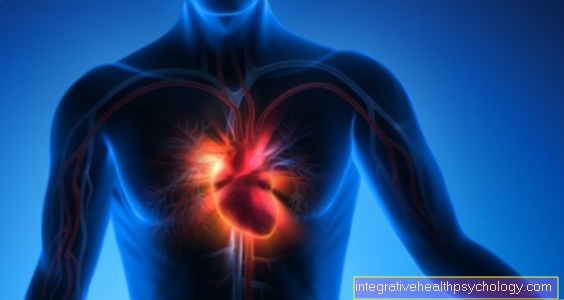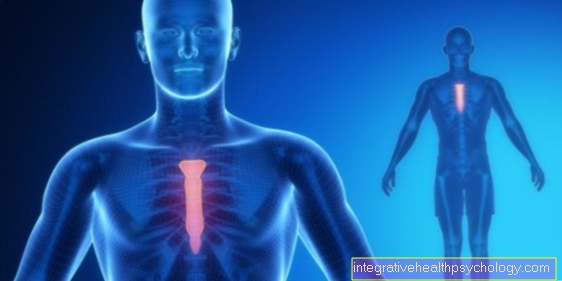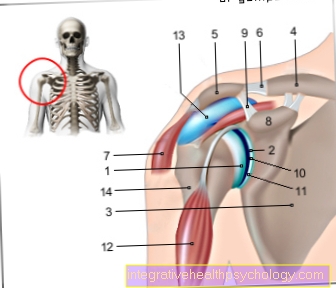Obesity causes
Altered basal metabolic rate / BMR (basal metabolic rate)
Basal metabolic rate will the amount of energy called, which the body of a relaxed person needs 12 hours after the last meal at a constant room temperature of 20 degrees per day. This amount of energy is required so that the organs can work, the metabolism works and the body temperature can be maintained.
The basal metabolic rate depends on:
- gender
- Age
- Size and
- Weight.
There is the following rule of thumb for the calculation:
Basal metabolic rate women (in kcal) = 0.9 x body weight in kg x 24
Basal metabolic rate men (in kcal) = 1.0 x body weight x 24
Men have a higher basal metabolic rate than women because they have more Muscle mass and muscle cells consume more energy than fat tissue, even at rest.
Women naturally have less muscle mass, for that more adipose tissue as men.
Teenagers have in the Growth phase a higher basal metabolic rate than adults. Women have a higher basal metabolic rate during pregnancy and while breastfeeding. With increasing age, the basal metabolic rate decreases and the probability of being overweight increases.
Genetically determined (inherited) basal metabolic rate
The Basal metabolic rate becomes inherited.
In 1986 studies found that the variance in the basal metabolic rate between families was four times as high as within a family. This is explained by the different muscle fiber composition. This is one reason why people gain weight at different rates and at different rates with the same, excessive energy intake. A low, inherited basal metabolic rate can lead to overweight (obesity).
Thermogenesis
This is understood to mean the additional consumption of energy through heat-producing factors such as food intake (“thermal effect of food”) and digestion.
10% of the basal metabolic rate can be added for this effect.
The basal metabolic rate always relates to people in complete calm. The daily energy consumption is made up of
- Basal metabolic rate
- Thermogenesis and the
- Performance turnover.
Performance turnover
Of the Performance turnover is the amount of calories that goes through Move and job is consumed in addition to the basal metabolic rate. It is very different depending on the physical activity and individually.
To estimate the total energy expenditure, multiply the resting energy expenditure for men by 1.6 and for women by 1.5 if they are not very physically active; for moderate and vigorous activity, multiplications are by 1.8 and 2.0 for men and 1, 7 and 1.9 displayed in women.
Note: Obesity always results from a positive energy balance.
Physical activity
The spontaneous physical activity seems to be genetically anchored. Physical inactivity can root cause for a positive energy balance (excess Calories which are converted into fat).
Most of the time, overweight / obesity is a mixture of both: little exercise and too much energy intake.
Nutritional habits

Undoubtedly is one Overeating one of the main reasons for the emergence of Obesity. Eating habits, eating habits and preferences for certain foods are very different in the individual families.
Overweight people often prefer foods with them high energy density i.e. High in fat and sugar or a combination of both.
These foods are tasty, low in volume, high in energy (high in calories) and low in satiety.
Also the recorded one alcohol plays a role. It promotes weight gain and thus the emergence of excess weight not only as an additional one energy supplier, but also as Fat Burning Inhibitors.
Mental causes
Stress affects eating behavior. "Anger hits the stomach"Or"The way to a man's heart goes through his stomach“Are sentences that show that anger, conflict, work, exams, noise, but also boredom, loneliness and grief (bacon) can increase food intake in some people.
In terms of their personality traits, however, overweight people are no more or less noticeable than people of normal weight.
You can find a lot of helpful information on this topic written by our medical psychotherapist Christoph Barthel under: Obesity and psychology
Eating behavior
The eating behavior of overweight people often shows characteristic features and symptoms.
- Snacking ("nibbling")
Frequent consumption of small amounts of food, mostly readily available and good-tasting food, without hunger, leads to obesity. - Cravings
The focus is on the intense desire (no hunger) for a certain food outside of meals. The person concerned can usually not resist this wish. People eat until they are full, not beyond. The amount of food eaten varies. - Vomiting / bulimia
In contrast to snacking or cravings, vomiting is denied in most cases. Vomiting as a weight control measure is mostly found in women. In women> 30 this behavior is found in 8% of all cases, in younger women in up to 20%.
You can find more information under our topic bulimia.
Read more on the topic: Weight loss and alcohol - how do they go together?
Social status
In the MONICA PROJECT it was demonstrated that in Germany social status has similar effects on weight as in other industrialized countries.
The lower the social class, the higher the weight. This trend is particularly evident in women; Those with a secondary school leaving certificate were 4 times more likely to be overweight than those with a high school diploma or a comparable school leaving certificate.
Medication
A number of drugs and hormones can cause weight gain. Some of these drugs are included Antidepressantse.g. Zoloft and neuroleptics. A well known weight loss drug is Almased. Other drugs that must be mentioned are: Sulphunylureas (drug against diabetes) and beta blockers (drug against high blood pressure). Furthermore, the intake of some hormones such as insulin, cortisone, estrogens (female sex hormone, e.g. as part of the pill) and Androgens (male sex hormone).
Genetic causes
Genetic syndromes (syndrome = together; group of symptoms that occur together at the same time)
A number of genetic (inherited) syndromes associated with obesity are known but rare. The most common and best studied are Prader-Willi syndrome and Bardet-Biedl syndrome.
Prader-Willi syndrome
First described in 1956 by Prader, Labhart and Willi. Even the newborn shows pronounced hypotension (low blood pressure), and drinking difficulties are evident.
Later behavior problems, stubbornness, impulsiveness. Abnormal eating habits, intake of huge amounts of food. Almost all affected are overweight with fat accumulation mainly in the abdomen. In both sexes, the secondary sexual characteristics are stunted and pregnancies are rare.
Read more on the subject at: Prader-Willi Syndrome
Bardet-Biedl syndrome
First described in 1936.
Associated with:
- Overweight (80%)
- Mental development retardation
- Retinopathia pigmentosa (inflammation of the retina with pigment deposits, visual field defects, blindness).
The frequency is given as about 1: 20,000. Eating disorders and obesity are usually less pronounced than in Prader-Willi syndrome.
Other causes
Secondary obesity (being overweight as a result of an illness)
Obesity can also result from a number of different diseases.
- Hypothyroidism (underactive thyroid)
Hypothyroidism is present in 5% of all overweight people. Complaints. Cold intolerance, dry, pasty skin, myxedema (swelling) of the face, constipation, slowing down, and weakness. Read more about this under Lose weight with hypothyroidism - Cushing's disease (overactive adrenal cortex)
Symptoms: full moon face, bull's neck, high blood pressure, trunk obesity - Polycystic Ovary Syndrome (PCOS)
There is a cystic change in the ovaries. The production of androgens (male sex hormone) is increased and thus leads to obesity.
Further information
You can find more information about the causes of obesity at:
- Main theme Obesity
- Obesity
- Lose weight
- Body mass index
- Forms of obesity
- Overweight in children
- Determination of body fat
- Assessment of body weight
- Obesity and psychology
Further general information that may also be of interest to you:
- Determination of body fat
- Adipose tissue
- Assessment of body weight
- Calorie-conscious diet
- Wholesome nutrition
- Nutritional therapy
- eating disorder
All topics that have been published on the field of internal medicine can be found at: Internal medicine A-Z





























